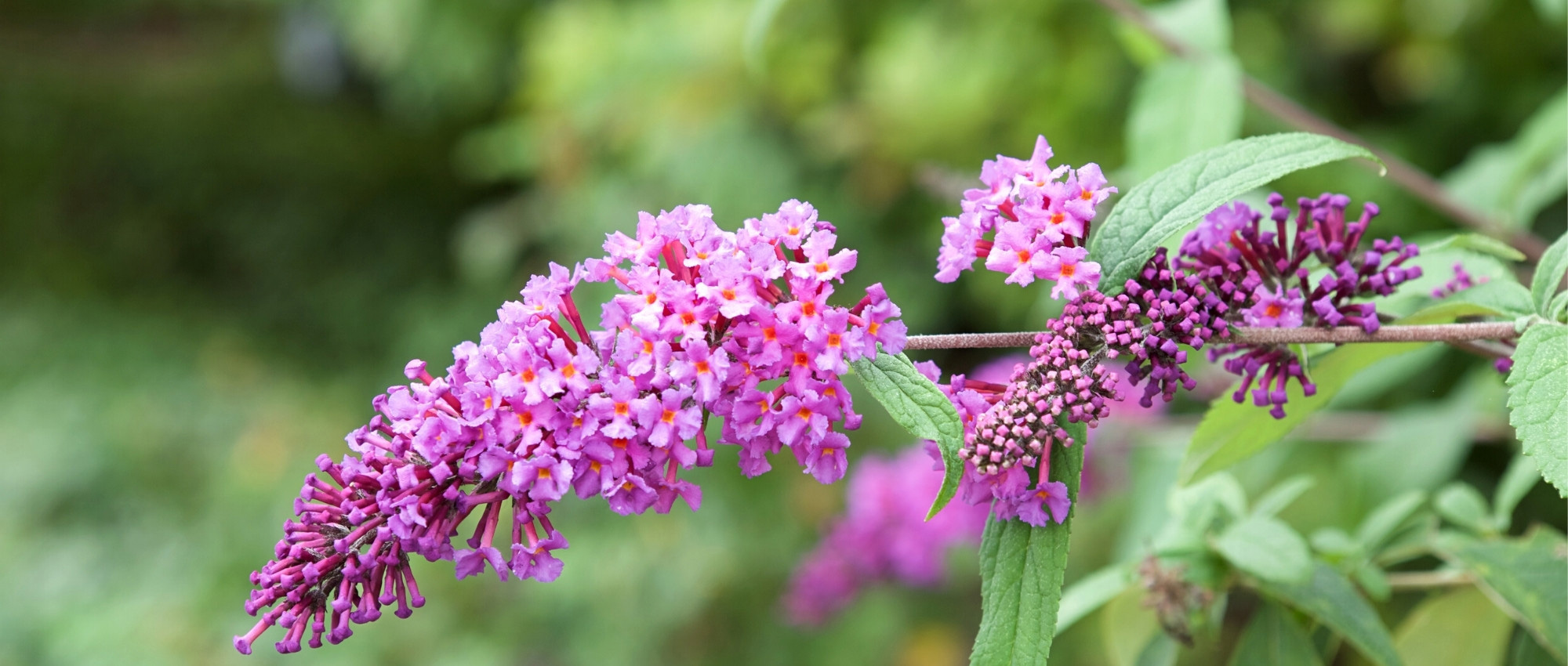
10 bushes with long flowering
To enjoy it for months!
Contents
Abelia, Hibiscus, potentilla or Buddleia: some bushes have the advantage of offering a very long flowering, which lasts for months. They are perfect for enlivening the garden and provide the assurance of a true spectacle that continues throughout the summer. Discover our selection of the 10 best long-flowering bushes, along with some tips for growing them and pairing them with other bushes and perennials to create stunning scenes. Most of them are in bloom for 4 to 5 months, from late spring until the first frosts.
For more options, check out our entire range of long-flowering bushes.
Abelia grandiflora
Abelia is a beautiful bush that flowers throughout the summer, typically from June to September-October. It produces numerous small white or pink funnel-shaped flowers, pleasantly scented. It forms a bush with a rounded and flexible habit, whose arching branches bear lovely dark green leaves that turn purplish in autumn. There are some very beautiful variegated varieties (‘Confetti’, ‘Sparkling Silver’, ‘Tricolor Charm’, ‘Hopley’s’…), ideal for adding colour to borders!
Abelia thrives in full sun (although it also tolerates partial shade), in any good garden soil that is well-drained. It is particularly sensitive to heavy, waterlogged soils, which can suffocate its roots. Compact varieties adapt well to pot culture, making it easy to place them on a terrace, in a small garden, or a courtyard. Abelia can withstand temperatures down to -15 °C.
Abelia is a stunning bush to incorporate into a free-flowing, flowering hedge. You can, for example, pair it with Buddleias, Philadelphus, Spiraeas, Ceanothus, Escallonia, Vitex agnus-castus, and Hibiscus syriacus.
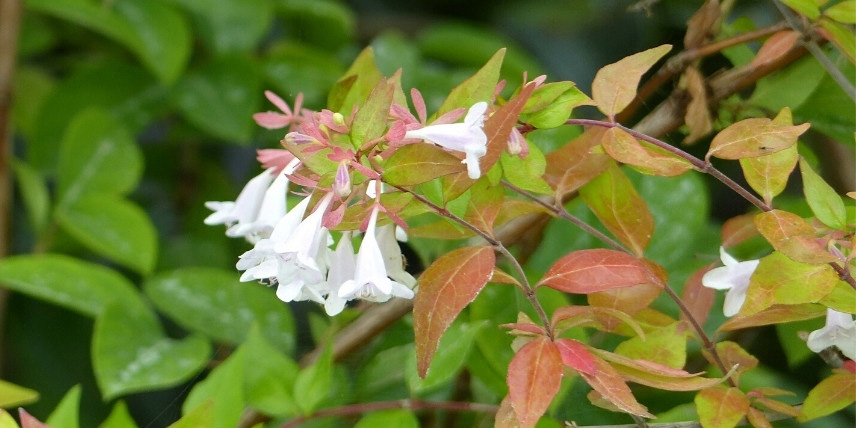
Abelia grandiflora ‘Francis Mason’
Hibiscus syriacus
Hibiscus syriacus, also known as Althea, is a beautiful bush with ephemeral flowers that continuously renew from July to October. Depending on the varieties, the flowers are available in shades of white, pink, mauve, or blue. Typically, the flowers are single, consisting of five large petals, but there are also varieties with double flowers that have a lovely crumpled appearance.
In the garden, plant it in full sun (or in light shade in the southern regions of France), in well-drained soil that remains moist. It prefers light soils rich in organic matter. Quite hardy, it can withstand temperatures dropping between –15 and –20 °C at most.
You can plant it at the back of a naturalistic perennial border. For example, pair it with Gaura, Verbena bonariensis, Penstemon, Sedum, Aster, and paniculate Phlox. It will also find its place in a romantic-style garden, especially if you choose the varieties with double white or pink flowers, which have a lovely crumpled appearance.
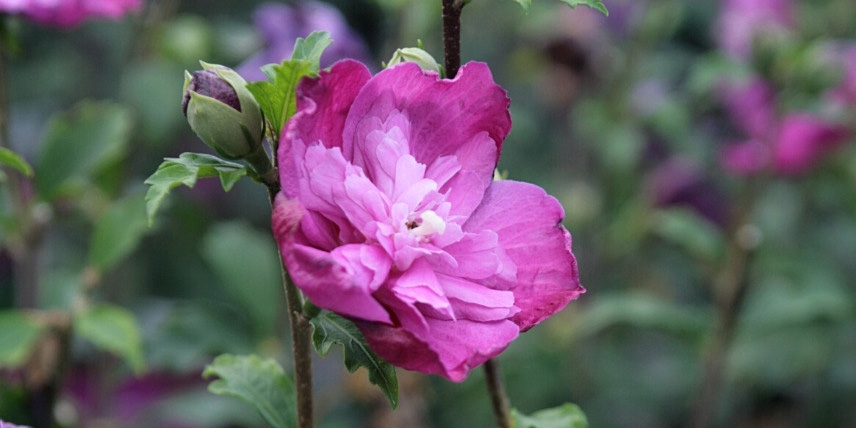
Hibiscus syriacus ‘Purple Ruffles’
Discover other Shrubs
View all →Available in 0 sizes
Available in 1 sizes
Available in 1 sizes
Available in 1 sizes
Available in 1 sizes
Available in 1 sizes
Available in 1 sizes
Available in 1 sizes
Available in 1 sizes
Available in 1 sizes
Hydrangeas
Hydrangeass offer an impressive flowering display that lasts all summer, typically from June to September. They bear large flat or spherical inflorescences, generally blue or pink, sometimes white, mauve, or red… The colour of their flowers also varies depending on the pH of the soil: the more acidic it is, the bluer they become, while the more alkaline the soil, the more the flowers take on a pink hue. The inflorescences are usually flat or spherical. We particularly recommend the Hydrangeas from the ‘Endless Summer’ series, specifically selected for their very long flowering period! You might choose Hydrangea ‘Endless Summer Bloomstar’, with pink flowers, ‘Endless Summer The Bride’ with white flowers, or ‘Endless Summer Twist and Shout’.
Hydrangea macrophylla enjoys shaded locations: you can incorporate it into a woodland garden alongside Digitalis, ferns, Hostas, and Geranium nodosum. It will also find its place in a romantic-style garden (with Astrantia, Digitalis, Gypsophila…) or in a cottage garden, alongside hardy geraniums, Campanula, and Delphinium.

Hydrangea macrophylla ‘Endless Summer Twist and Shout’
Read also
Pruning of summer-flowering bushesBuddleia
Buddleia, or Butterfly Bush, is a bush that flowers profusely throughout the summer, from June-July until September-October. It bears spike flowers, generally in blue, purple, pink, or white, whose fragrance attracts butterflies.
True all-terrain bushes, Buddleias grow anywhere, even in poor soils. They grow quickly and withstand pollution without any issues. They thrive in full sun, sheltered from strong winds, in well-drained soil. As for maintenance, they should be pruned back in late winter.
Buddleias are perfect in a flowering hedge, for example with Japanese Spiraeas, Cotinus, and Ceanothus. With their wild and natural style, they will create a stunning backdrop for a cottage garden. Pair them with Achilleas, Echinaceas, Knautias, Salvias, Nepetas, Echinops, Stipa, and Miscanthus.

Buddleia davidii ‘Pink Delight’
The shrubby cinquefoil
The Potentilla forms a small bushy shrub, reaching heights of between 1 m and 1.5 m, and bears lovely five-petalled flowers from June to September, measuring 2 to 5 cm in diameter, in bright and vibrant shades. The flowers can be yellow, pink, bright orange, or white… The Potentilla also has beautiful deciduous foliage, both fine and dense.
The Potentilla is an easy-going shrub that grows almost anywhere and requires no special care. It thrives in full sun. Very hardy, it can withstand temperatures down to -25 °C.
The Potentilla will easily find its place in a naturalistic garden, alongside Gaura, Achillea, Eryngium, Verbascum, and Centranthus ruber. Bring in some lightness by placing clumps of grasses, such as Stipa tenuifolia, among these perennials. The Potentilla is also ideal alongside other warm-flowering plants: think of Heleniums, Echinacea, Agastache, and Hemerocallis… for a bed full of vitality!

Potentilla fruticosa ‘Pink Paradise’
The Oleander
Oleander (Nerium oleander) is a beautiful Mediterranean and evergreen bush that offers a generous summer flowering. Generally, the flowers are pink, red, or white, but there are also varieties with yellow or orange flowers. It also bears beautiful dark green, elongated leaves that persist in winter. It is the essential bush for Mediterranean gardens! It has a bushy, rounded, and graphic habit.
Oleander enjoys warm and sunny locations. It is drought-resistant, but to flower for a long time, it is best to ensure regular watering in summer. If it benefits from heat and soil that remains cool at depth, oleander can flower generously for 4 to 5 months. In cooler regions, oleander can also adapt to pot culture, allowing it to be brought indoors for winter.
Oleander is the indispensable bush in a Mediterranean-style garden. You can pair it with lavenders, santolines, Euphorbia characias, helianthemums, strawberry trees… not to mention the stunning twisted silhouette of the olive tree.
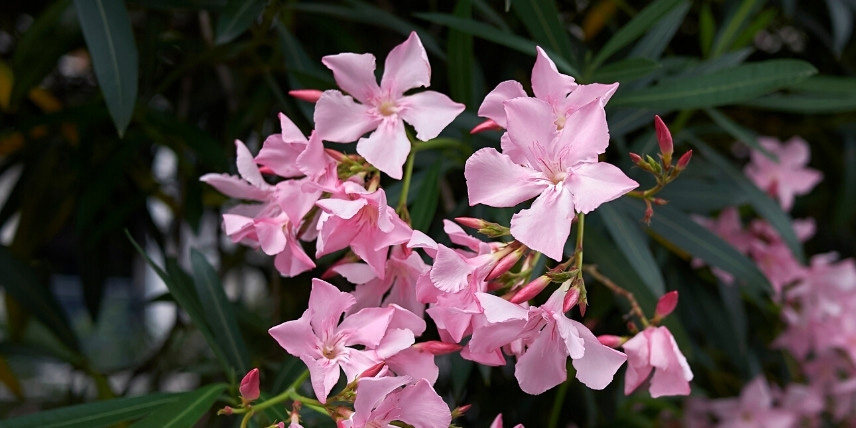
Nerium oleander
St John's Wort
St. John’s Worts are easy-to-grow bushes that produce beautiful, bright yellow flowers. Their flowers consist of five petals surrounding a bouquet of golden-yellow stamens. Their habit varies greatly depending on the species: some form groundcovers while others are bushy.
We recommend, for example, Hypericum ‘Hidcote’, a bushy St. John’s Wort that reaches between 1 and 2 m in all directions and offers a long flowering period from July to October, with cup-shaped golden-yellow flowers. Also discover Hypericum moserianum, which flowers for nearly 4 months, from June-July to September-October. Finally, the various varieties of Hypericum inodorum provide, in addition to their long flowering, decorative fruits that extend interest into autumn.
St. John’s Wort is a foolproof shrub that will find its place both at the edge of a flowerbed and in rockeries or on slopes. It grows quickly, is quite hardy (down to -15 °C), and adapts to any well-drained soil. You can pair it with other bright flowers: Achillea ‘Moonshine’, kniphofias, rudbeckias, daylilies… You can play with complementary colours to create a highly contrasting flowerbed: since purple is opposite yellow on the colour wheel, don’t hesitate to combine these two shades, as they will enhance each other! Consider, for example, Salvia nemorosa ‘Serenade’, Perovskia atriplicifolia, and Penstemon ‘Midnight’.
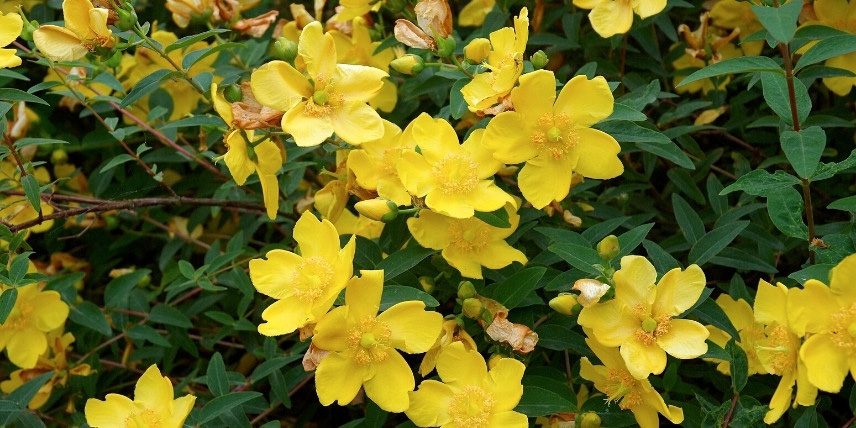
Hypericum ‘Hidcote’ (photo Wouter Hagens)
Weigelas 'All Summer'
Weigelas usually flower in May-June; however, those from the ‘All Summer’ series are distinguished by their very repeat flowering, almost continuously from April to September. For example, you can choose Weigela ‘All Summer Red’, which offers beautiful funnel-shaped flowers in bright red-pink. Or the Weigela ‘All Summer Peach’, whose flowers display a mix of pink, apricot, and peach shades. Its tones are both warm and delicate. There is also a variegated variety, a bit rarer: ‘All Summer Monet’, with pink flowers and dark green leaves edged in cream and pink. You can also choose Weigela florida ‘Bristol Ruby’, which flowers from June to September.
Weigela grows quickly. It is not very demanding regarding soil type, as long as it is not too dry, and it appreciates calcareous soils. It thrives in full sun or partial shade in the south of France. Enjoy Weigela to create a romantic border by pairing it with roses, mock oranges, gypsophila, ‘Sonata’ cosmos, and hardy geraniums.
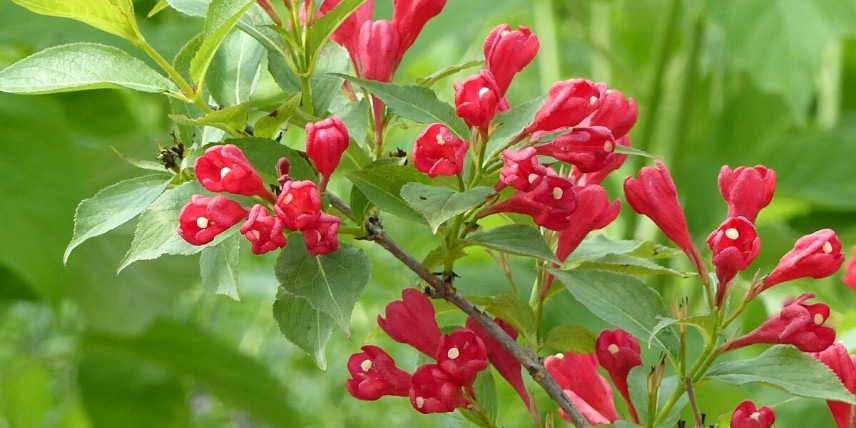
Weigela ‘All Summer Red’
Daphne transatlantica 'Eternal Fragrance'
Daphne ‘Eternal Fragrance’ forms a small, rounded, and dense bush, not exceeding 80 cm in all directions. It offers a pleasantly fragrant flowering that lasts a long time, for 5 to 6 months. It blooms from May to July, then has a second flowering in September-October. It bears pink buds that open into very fragrant, tubular white flowers. Its long and abundant flowering is appreciated, as it literally becomes covered in flowers. The white flowers are highlighted by its dark green foliage.
You can also choose the Daphne ‘Pink Fragrance’, which also offers a very long flowering period. It behaves in much the same way, blooming for the first time from May to July, then flowering again in September-October. Its flowers are pink and also very fragrant.
Daphne thrives in partial shade, sheltered from scorching sun and cold winds, in fresh, well-draining, humus-bearing soil. With its compact habit, it is perfectly suited for small city gardens and adapts easily to pot cultivation. With its rounded and compact shape, it will be perfect as a border in a graphic, contemporary bed. Pair it with ferns, bamboo, hostas, Fatsia japonica, Nandina domestica, Angelica gigas, and Selinum wallichianum… not forgetting grasses like Hakonechloa macra and Carex morrowii.
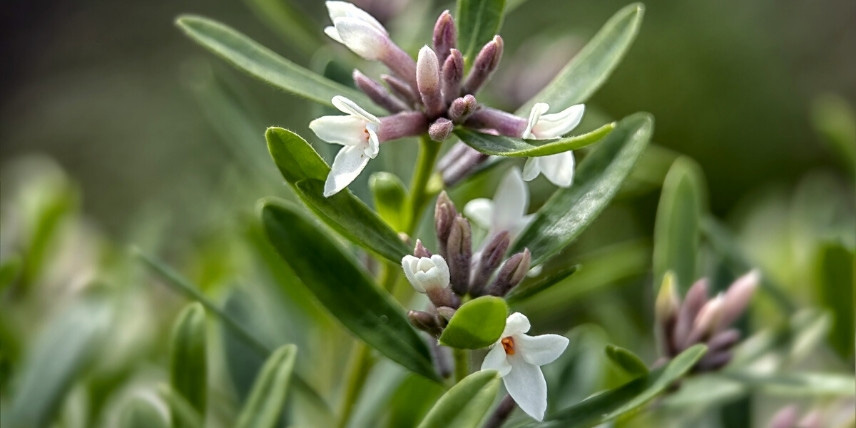
Daphne ‘Eternal Fragrance’ (photo Adobe Stock)
Deutzia setchuenensis 'Corymbiflora'
The Deutzia setchuenensis ‘Corymbiflora’ stands out from other species due to its very long flowering period, lasting 4 to 5 months: it flowers from June until September-October, with a brief pause in mid-summer. It produces stunning star-shaped white flowers with five petals, which are slightly fragrant. This is a compact variety, not exceeding 1 m in all directions. It is perfect for small gardens and also adapts well to pot cultivation! Its light and delicate flowering is much appreciated.
It thrives in full sun or partial shade in warm climates, ideally in humus-bearing, deep, cool, and well-drained soil, even calcareous. It is particularly sensitive to compact and waterlogged soils in winter. It is perfectly hardy, tolerating temperatures down to -20 °C. Plant it sheltered from cold winds and scorching sun.
Enjoy its immaculate flowering to create a white garden! Pair it with the white flowering of Gaura ‘Snowbird’, Epilobium angustifolium ‘Album’, gypsophilas, digitalis purpurea ‘Alba’, and campanula lactiflora ‘Alba’. You can also add some touches of pink and silver foliage (Stachys byzantina, wormwoods…) to achieve a very romantic atmosphere.

Deutzia setchuenensis ‘Corymbiflora’
- Subscribe!
- Contents
































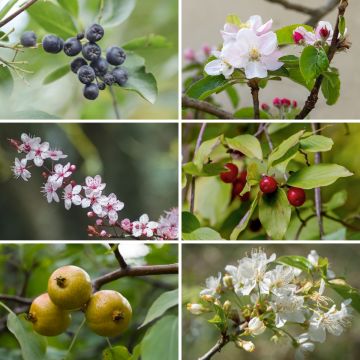
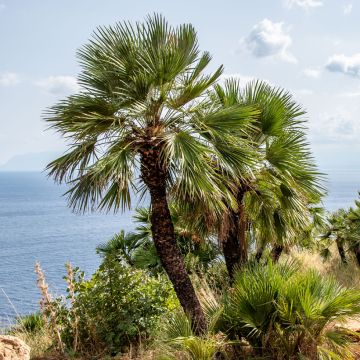


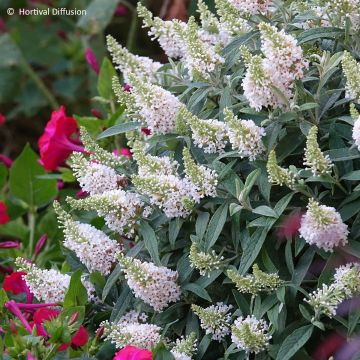
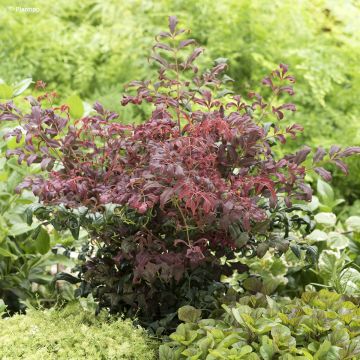
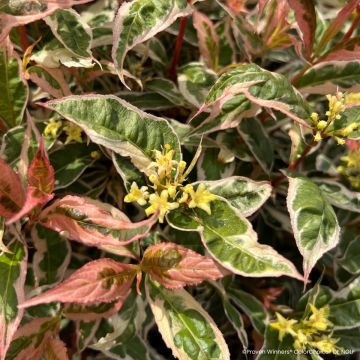
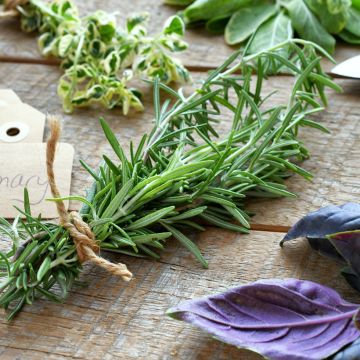
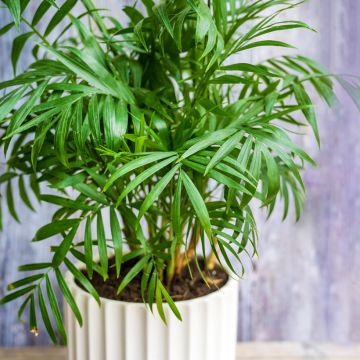
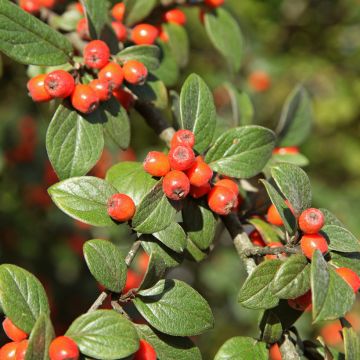
Comments